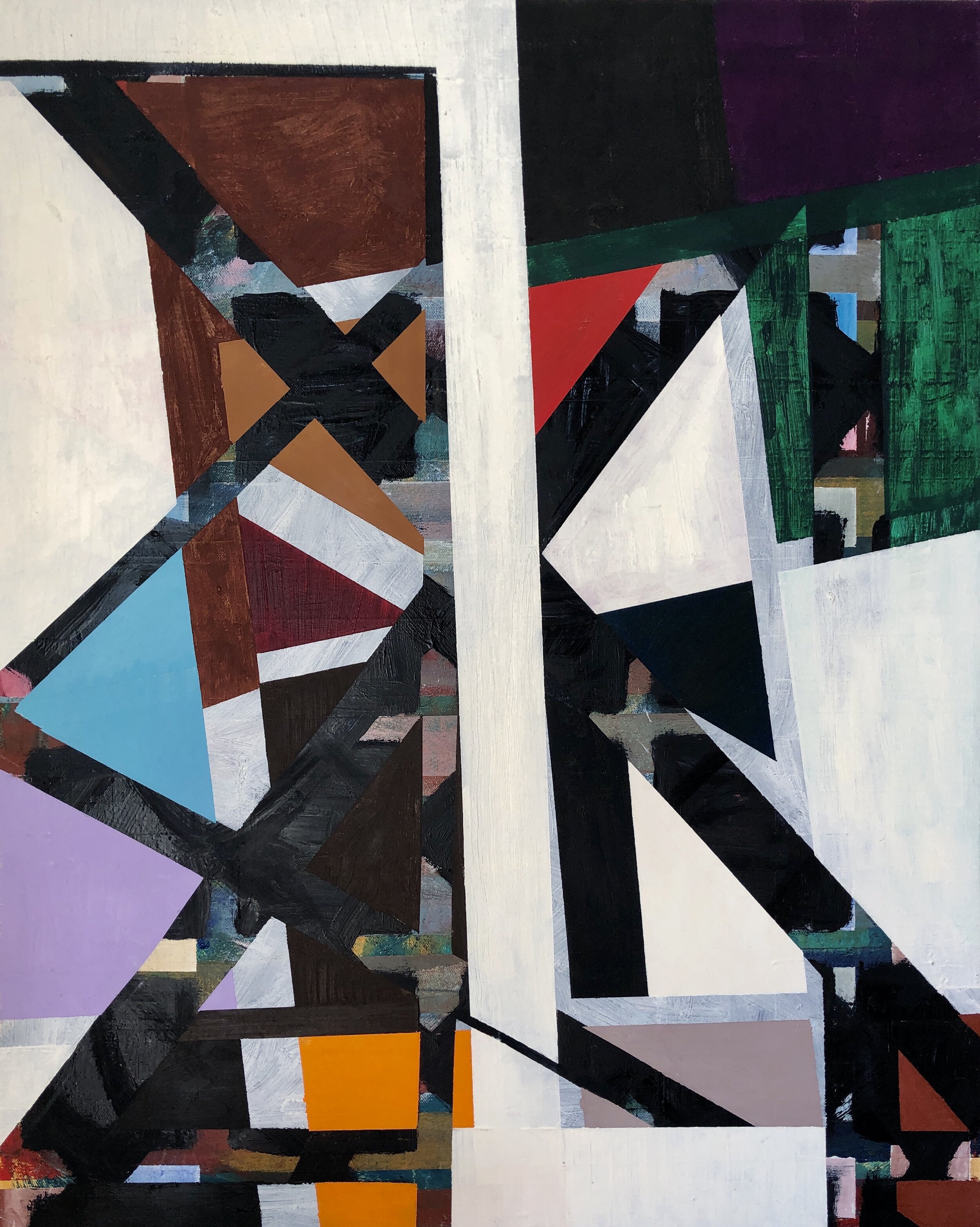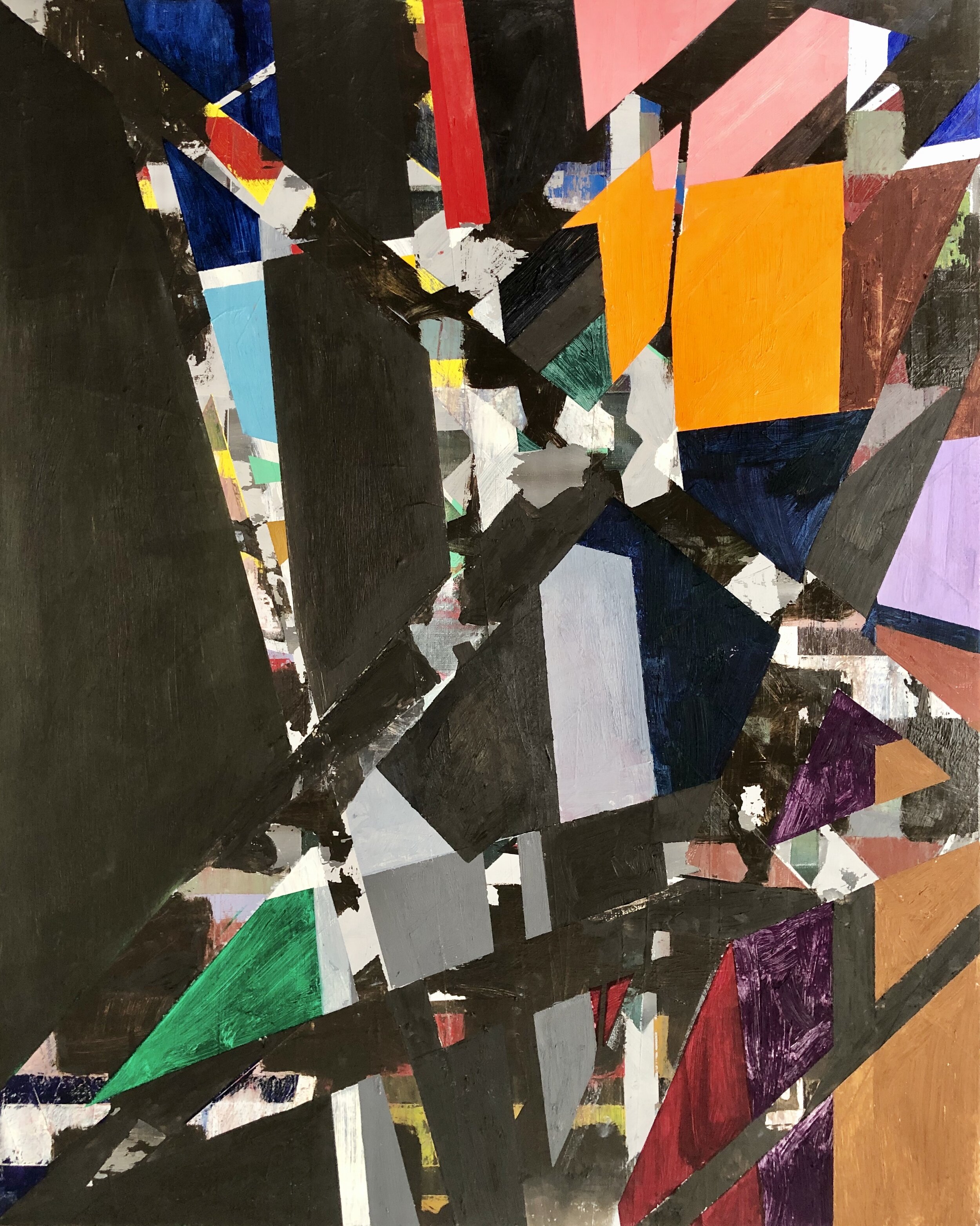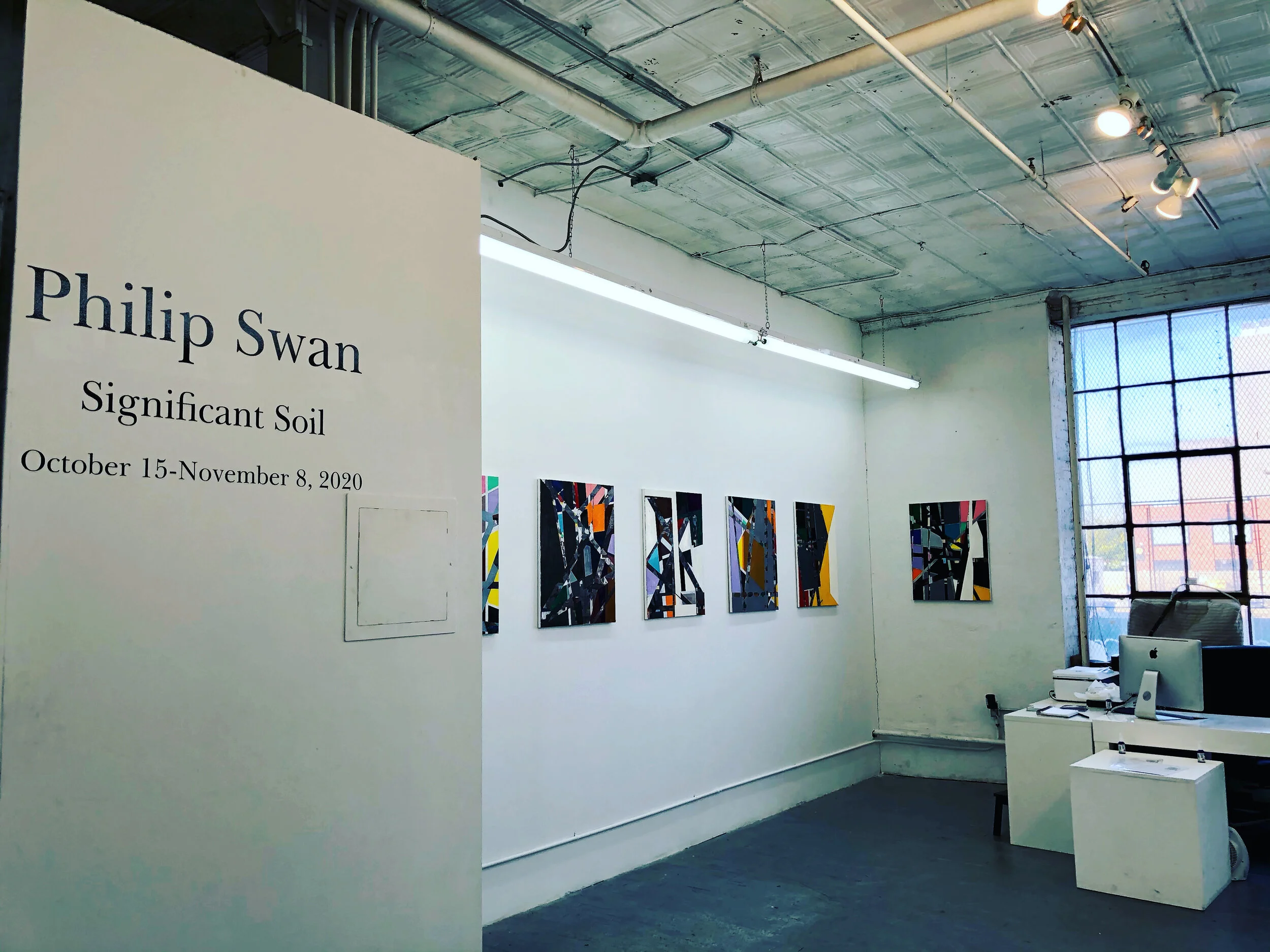Amos Eno Gallery, October 15-November 8, 2020
2020 F
This is a pre COVID painting: it is balanced, reflective, restful. The line in the middle of the canvas bisects it in an orderly way. All over compositions of oblique, asymmetric chromatic planes. The irregularity of the diagonally interlocking shapes and colors throughout the overall design gives the paintings an organic quality, creating movement and rhythm. Each move the artist makes depends on the moves that came before, like a game of chess: “I think of my process as akin to a game of chess. The works all start out as a blank white canvas, just as every game of chess starts with the pieces laid out in the same way. I begin with thin washes of color, and then work over that layer with more opaque layers of paint. These are my initial moves in the chess game, moving the pawns around to lay an initial groundwork. As I superimpose layers through masking little surprises start to crop up, just as an opponent in chess will make a move you were not anticipating: you had planned an elaborate trap on the right side of the board and your opponent makes a bold move on the left side that throws off your entire plan. The same happens when something in the previous layer gains a prominence it did not have due to overlapping planes of color: you think, ‘you sly devil, I hadn’t noticed that at all.’ When the painting is done it’s always interesting to see what parts of the initial layer have survived, have been given a totally unplanned prominence as the game progressed.”
The title comes from the T.S. Eliot poem “The Dry Salvages,” in which Eliot ruminates on those individuals who are undefeated in life because, in the process of continuing to strive, they accumulate a life of “significant soil.”
2021 D
The harder it is for the artist to reconstruct the steps the more compelling the process is. The grays in this work were the same for more than one layer, making it even less clear which came first even though there are clearly layers masking other layers. The application of paint is straightforward: directly from the tube. Rough surface textures are important because the artist wants the materials of painting to be in the foreground, affirming the painting as object. Initial layers of oil washes are overlaid with oil stick stripes worked over with a palette knife and then overlaid with a geometric structure. Color and form are inseparable, and the viewer is therefore asked to navigate the ambiguity between foreground and background, trying to unravel how the traces of layers were constructed. The use of grays in the palette and the emphasis on layering owes a debt to Jasper Johns. “Jasper Johns has inspired my emphasis on surface texture and layering, like the flag paintings where when you look carefully you can see the text of the newspaper underneath: it’s those little surprises that I find compelling. I love Diebenkorn and the “Ocean Park” series is an amazing distillation of a place abstracted that I draw on repeatedly. I’m also a big fan of Philip Guston because Guston was a student of history, specifically Classical history in Rome and Greece, and while his work is definitely modern the fact that it draws on artwork and ideas that have transcended millennia is in keeping with what I like about TS Eliot. Be modern in technique but be cognizant of the larger cultural conversations that have come before and shaped how we see things today.”
Like the buildup of soil in nature echoed in Eliot’s poetic metaphor, Swan’s work addresses the mental accretion of imagery permeating urban settings that lend a sense of place and meaning which is internally mapped in abstract ways. Most of the work in the show was created during the CoVid-19 pandemic, and reflects the struggle required to create art in this context. The continuing resilience needed to build a life of significant soil in the face of an existential crisis on a global scale lies embedded in the work on display. This show consists of thirteen oil paintings on canvas. The paintings are self-contained, but connected through color and compositional similarity. In the process of creating work, Swan conceives of compositional and aesthetic roadblocks and then improvises his way to a solution while avoiding resolving problems concretely, thus allowing previous stray pathways which eluded resolution to remain visible. The resulting pentimento gives the work its complex composition.
2021 D
The artist is influenced by the work of Richard Diebenkorn in terms of using abstraction to capture a sense of landscape. New York City is a world of straight lines and superimposed forms that change as you move through it. “The surface texture of the work is important, I’m not interested in a polished finished surface, I want people to sense the physical nature of paint, to see brush strokes, to see the dripping nature of oil thinned with solvents. This keeps the work grounded as an everyday thing, it’s not a precious object formed whole on another plane of existence. My work definitely references the urban environment in terms of its geometry: I think of a photo I once took on the elevated platform of the 7 train where I was looking down on the track. You see the receding yellow edges of the platform on either side and then the silver rails below that running parallel to the yellow edged platform and then the cross ties at right angles to the platform and rails and then, through the cross ties, you can see the asphalt below with the yellow lane markers showing through and echoing the yellow of the platform edges. This is one of countless compositions you see all of the time in New York, entirely unplanned, but unique to an urban environment anywhere. How can you ever get sick of these little visual surprises? And all of this, of course, is in dialogue with the natural geography of the place: one obvious example is Central Park where the manhattan schist intrudes upon the orderly geometry of the buildings and streets girding the park.” The geometry of the city is internalized for the artist, snatches of the city in the mind’s eye because it is impossible to see or comprehend it in one view. The internalized landscape becomes abstracted, a map of the world that you negotiate with others is a world you also negotiate within yourself. “When I bring New York to mind I have the street map in my mind, and that is overlaid with the subway map, and then when I think of a specific neighborhood I try to summon up what is on the corner of cross streets. For instance, if you mention the Upper East Side I think of 86th street, I think of the 6 line to get there and where it drops me off, then I think of the corner of say 86th and Lex as opposed to 86th an Park or 86th and 5th, which all call to mind very different buildings and neighborhoods even though they are all on 86th street. As I’m working on a painting I’m not thinking of a specific neighborhood, or street corner, it’s more a consolidation of everything I’ve seen up to that point, or at least in recent memory, along with how I feel at the moment.”
Swan has explored geometric abstraction in various mediums over the past two decades, and his recent work is highly architectonic in feel. This series incorporates both the palette and geology of the natural world and the vertical geometries of the urban environment. Significant Soil marks a new trajectory that combines formalist geometric abstraction with a more gestural mark-making than has been seen in previous work. Like other contemporary abstractionists, Swan is in dialogue with the rich history of abstract art in the United States inspired by the interaction of the artist and landscape.
2021 F
This work was created in April 2020 at the height of the COVID crisis in New York City. “The outbreak of COVID has put the arts in perspective for many people. For artists, there is the question of the relevance of creating art in a public health emergency, there is the need for motivation when there are so many demands on their attention, there is the feeling of speaking to a void with galleries and performance spaces closed, and there is the ever present uncertainty of what kind of art world will be left standing when it ends. Throughout this crisis I have been referring back to the idea of living a life of significant soil, as TS Eliot puts it. Eliot’s work tries to shore up meaning in the wake of the World Wars, and I find inspiration in that sentiment as we try to cobble together a meaningful life in this awful year.” The work created over the course of the pandemic is less orderly and restful, the compositions seem more chaotic. Forms seem to be splintering, collapsing, there is no repose. While the artist uses hard edge geometry it is not about purity of form: it is messy, like life, geometry enmeshed in a burgeoning mess as chromatic planes overlap gestural elements. In this sense, the artist’s work is a transcription of a lived experience in a specific context.
Philip Swan is a self-taught painter who has been showing at Amos Eno since 2018. He has a BA and MSI from the University of Michigan and an MA from the College of William and Mary. He is originally from Michigan and has lived in New York since 1997. His work has been featured in many group shows in Manhattan, Brooklyn, and New Jersey.
2021 B
This work is an excellent example of the artist’s use of pentimento: the appearance in a painting of earlier elements subsequently painted over. This is a visual record of the accumulation of ideas, of what is kept and what is lost. There is a line down the middle of this canvas, created during COVID: it bisects the canvas but lends to the feeling of shattering and collapse, it doesn’t lend to a sense of order or reflection. The evolution of absolute control and chance as prior layers come to light relate to each other in almost three dimensional ways. “In my work I like to balance chaos and collapse with order and reflection. I feel a work is complete when these two are balanced because when that balance comes the work can stand on it’s own. Many abstract artists describe works as being done when they have their own presence, a presence independent of their creator, almost like children stepping away from their parents as adults in their own right. It’s obviously arbitrary, but for me it gets back to the chess game: when my opponent surprises me, when I realize there is a logic revealing itself independent from my own, that’s when I know it’s time to stop.”





